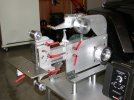Money well spent is something that often pays for itself.
Start with a Reeder basic chassis. Be sure to add the wheel set. Reeder's wheels are perfectly tuned and balanced. It is called the basic chassis, but it is a complete vertical/horizontal grinder package with flat platen, contact wheel arm, work rest, etc. That, plus a motor will give you a very good grinder. Add a contact wheel and you have a fully capable pro-shop tool. Their wheels are turned to .002" tolerance.
Reeder Belt Grinder / Sander 2" x 72" - Basic assembly Includes: Assembled grinder / sander ready to mount to motor and VFD (Sold seperately) Adjustable platen with 1 1/2" square attachment bar (20" long) Work rest (11 3/4" x 4" x 1/4") Additional 1 1/2" square attachment bar (20" long)(for work...

reederproducts.com
Contact wheels:
Smooth Contact Wheels Machined true within .0020 TIR (Total Indicator Reading) by Reeder Products, Inc. before shipping 2" Wide Rubber Contact Wheel Durometer 70 1/2" ID Cast Aluminum Hub Serrated Contact Wheels - Helps dissipate heat Machined true within .0020 TIR (Total Indicator Reading) by...

reederproducts.com
For a motor and VFD, I use this chap. You can get combos from 3/4HP to 2HP.
Find many great new & used options and get the best deals for KB Electronics KBAC-27D, Techtop Motor & Drive Package Belt Grinder VFD 2X72 56C at the best online prices at eBay! Free shipping for many products!
www.ebay.com
Reeder's
mobile base is heavy duty and rock solid. Being able to roll the grinder to where you want it ... or outside ... is a valuable shop asset.
Complete Bench Legs Bench Plate VFD bracket to mount VFD Stanchions Casters Qty: 2 and two adjustable legs Handle All Screws for assembly (assembly required)

reederproducts.com
Then you can add any
special tooling and accessory arms you want ... or do what many folks do and build your own tooling with 1.5" square aluminum bars and plates as you need.
Or, if you wish, get the
full package with everything in a box.
RPS Motor and VFD 2" x 72" Belt Grinder / Sander Package with Motor (Nema 56C frame)(1 yr warranty from Original Equipment Manufacturer) KBAC Drive (1 yr warranty from Original Equipment Manufacturer) Includes: Assembled grinder / sander ready to mount to motor and VFD (Wiring kit not included)...

reederproducts.com
Their surface grinder is amazing. It isn't as cheap as it was, but it is worth every penny. Again, get their contact wheel with it. I recommend using a double arm and clamp with the surface grinder (adds less than $100)
RPS1000 Surface Grinder *Please allow 1-2 weeks to ship after receipt of order * https://youtu.be/gZKW-ne3sHk - RPS1000 Surface Grinder https://youtu.be/LnAavgjAK1w - Surface Grinder https://youtu.be/igTNXq4zHno - Tips For Surface Grinder * Surface grinder does not come with any contact wheel*...

reederproducts.com




